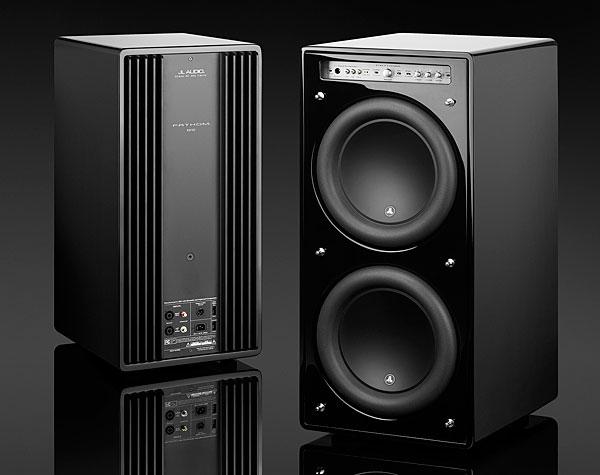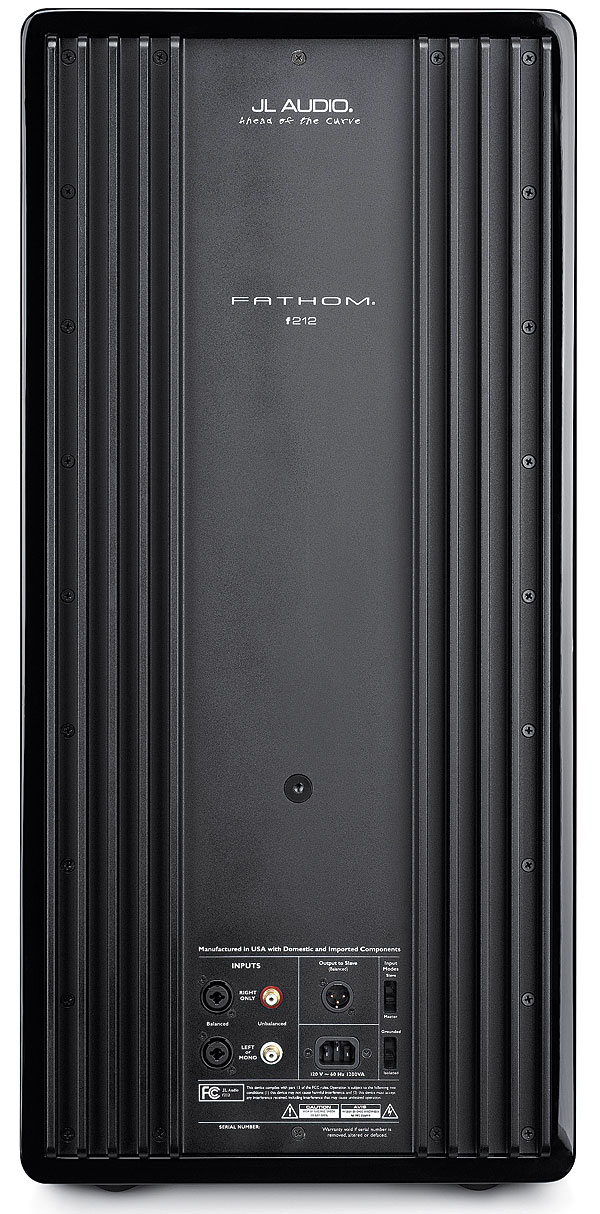JL Audio Fathom f212 Subwoofer

Unless you live in South Florida or are heavily into car audio, there’s a good chance you don’t recognize the name JL Audio. That’s because while these guys make dozens of products for automobiles and boats, they only make a few for home theaters. And the cheapest ones—the just announced 10-inch E110 and 12-inch E112, cost $1,300 and $1,600, respectively.
From there, the bass goes lower and louder while the price goes up. Wanna know how low and loud? About six years ago, CEDIA held its annual convention in the old RCA Dome in Indianapolis. I remember walking into the covered stadium and being absolutely assaulted by wave after wave of blasting bass notes. As it turned out, the amazing boom was coming from the other side—literally a football field away! This was the year JL Audio introduced its fearsome, Gotham g213 subwoofer, a truly scary, $12,000, bowel-busting behemoth that, amazingly, uses only two 13.5-inch active drivers, a 3,800-watt amplifier, and a kickass attitude that frightened the voice coils right out of lesser (i.e., all other) subwoofers.

As much as I would have loved to review the 360-pound Gotham, the largest subwoofer that’s legal to possess in my state is the $6,200, 220-pound Fathom f212. (OK, it was just the largest that I could practically move around.) Actually, JL Audio sent me the Fathom f212-GLOSS, which retails for $6,300—not including tax, title, and license). The beast is still so massive, JL Audio includes a pack of furniture sliders in the box, so that after you’ve manhandled this thing into place, you can more easily make whatever minor positioning adjustments you feel are necessary. Probably with a helper or two.
The gorgeous, black monolith that is the f212 is built in the United States and measures approximately 15 inches wide x 32 inches tall x 20 inches deep. Behind the black grille on the front of the sealed cabinet are two active, 12-inch, forward-firing drivers. Also behind the grille, running along the top of the cabinet, is a narrow panel with adjustment knobs and switches for low-pass filter, phase, polarity, and ELF (Extreme Low Frequency) trim, as well as controls for a built-in Automatic Room Optimization (A.R.O.) circuit, plus the input jack for the A.R.O. microphone. (The microphone is included, by the way, which is not always the case with high-end correction processors.) Along the back are two long, vertical heat sinks and the left- and right-channel low-level inputs (both balanced and unbalanced), an AC power cord, and an output jack for connecting a second f212 (!) to the first. (And, yes, the Fathom f212’s instruction manual even talks about using up to four of these behemoths in your theater!)
You Call That 12 Inches?
Given its price, I was actually surprised to find only a pair of 12-inch drivers in the f212. I thought that there would surely be some elaborate combination of actives and passives, multichambered ported enclosures, or a bevy of drivers covering every darn inch of the cabinet, along with some special voodoo explanation of how it all works together. The real story is much more pedestrian: It’s all about good, basic design and intelligent execution. The cones of those two 12-inch W7 drivers, for example, aren’t made from crazy, exotic materials such as Kevlar, titanium, sheets of sake-soaked birch, or dried-and-compressed Siberian yak dung. They’re actually made from boring, old, mineral-filled polypropylene skins that are bonded together at the perimeter and center of the assembly. Cut the cone in half from the outside to the center, and you’ll see that the back skin is shaped like a “W” due to the way it’s attached to the smoother front skin. Structurally, the underlayer provides support for the top layer in much the same way trusses are used to hold up bridges. This allows JL Audio’s engineers to get away with using a much lighter material and still achieve the rigidity they need in the driver. In fact, the company claims that the cone assembly of the 12-inch W7 driver is a whopping 32 percent lighter than a typical 12-inch, aluminum-alloy cone. (I couldn’t get an estimate on the yak-dung cone weight.)

Other vital-but-lacking-in-pizzazz technologies help keep the voice coil cool and ensure that the lead wires don’t flap themselves into oblivion as the coil forces the cone in and out. Something JL Audio calls its OverRoll Surround actually extends the cone surround material out and over the mounting flange. JL says this gives the cone itself more surface area within the same-size driver basket assembly. More surface area plus more cone excursion contributes to more air getting compressed and rarefied. Oh, yeah, having a built-in amplifier rated at 3,000 watts doesn’t hurt, either.
While it may be relatively easy to do with a typical, garden variety subwoofer, you don’t plop a 30-inch-tall, 220-pound box just anywhere in the room simply because “that’s where it sounds best.” In order to compensate for the fact that the f212’s placement may not be optimal, JL Audio built in Automatic Room Optimization circuitry that analyzes the shape and magnitude of the “primary response error” at the listening position and calculates an appropriate filter to correct for it and smooth out the bass performance in the room. It’s one of the fastest room correction routines I’ve used, and I found it does do a good job compensating for less-than-optimum placement.
Fabulous, Absurd, Insane
Some people, when given the chance to listen to a $6,300 subwoofer, would immediately play their favorite piece of music. I chose to start with “20 Hz Heartbeat.” I’m not sure exactly what I expected, but what I got was a throbbing, pulsing beat that immediately found anything loose in the room and began moving it. It even caused my son to walk across the hall and ask, “What the hell was that?” after the f212 had been very audibly shaking the bookshelves in his room. I’ve had subwoofers before that could create a very intense amount of deep bass in my theater room, but I’ve never experienced one that was capable of shaking things off of shelves in other rooms of the house. Neither of the other two subwoofers even came close to the amount of sheer energy and lung-emptying pressure being deftly plied by the f212. Let me put it this way: Had I been unfortunate enough to go into cardiac arrest at the time, I have no doubt that my family would have been able to restart me by laying me down in front of the f212 and playing back the track.

Speaking of heartbeats, although I’ve heard “Speak to Me,” the first track on Pink Floyd’s Dark Side of the Moon, too many times to count, listening to it with the Fathom f212 was an entirely new experience. Even before you can hear the heartbeats that gradually rise in volume at the beginning of the piece, you can physically feel them as they begin to permeate the room and resonate anything not made of stone. I’m not sure which was more impressive: the raw, brute power of the subwoofer, or the complete and effortless control of that power. Both came into play with S.M.V.’s “Lil’ Victa” in which the long, sustained, low-bass notes are rich and full of texture and aural flavor as the strings are plucked. And, amazingly, as extended in low bass as the f212 is, it was still adroit and light of touch while playing back the sharp bass attacks on The Cranberries’ “Dreams.” (I guess boring, old, mineral-filled, polypropylene cone material isn’t ready to retire yet.)
It wasn’t that long ago that I’d seen Harry Potter and the Deathly Hallows: Part 2 in the theater, but I certainly don’t remember it being anywhere near as impressive as it sounded in my theater with the JL Audio sub. While I could point to dozens of scenes, one of the most outstanding was when the movie comes alive with shudders, shocks, and thundering vibrations as Voldemort’s attack on Hogwarts begins. Perhaps the most notable part of this segment is when the stone statues are brought to action and they march to meet the giants across the bridge. The entire room—no, the entire three-dimensional space of it—shook with the mighty force of each footfall. Near the end of the movie when Voldemort attempts to, once and for all, destroy Harry, the shock wave created by his wand is almost unbelievably palpable in the way it rushes its way through the room.
Home on the Range
Not long after the Compact Disc first came out, someone explained to me that it wasn’t the fact that you could play them loud that made them so fantastic, it was that they had such amazing dynamic range. I kept thinking about that conversation whenever I was listening to the f212. What’s so spectacular about the sub isn’t that it can play a 20 Hz test tone loud enough to threaten liquefaction of your bowels. (OK, that is pretty spectacular!) What’s really incredibly phenomenal about the f212 is the range, and the total control over that range that it has. It was masterfully awe-inspiring. And now I have to say that I sincerely hate the folks at JL Audio because they have forever ruined any pleasure I might have enjoyed with any other subwoofer. I’ll never be able to listen to another without comparing it to the f212. I dare say that there are a scant few other subs out there that are capable of rising to that challenge. JL Audio’s Fathom f212 is more than just one hell of a subwoofer—it’s one hell of an experience.





























































